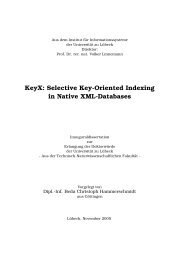Ataxie mit okulomotorischer Apraxie Typ 2: Charakterisierung des ...
Ataxie mit okulomotorischer Apraxie Typ 2: Charakterisierung des ...
Ataxie mit okulomotorischer Apraxie Typ 2: Charakterisierung des ...
Erfolgreiche ePaper selbst erstellen
Machen Sie aus Ihren PDF Publikationen ein blätterbares Flipbook mit unserer einzigartigen Google optimierten e-Paper Software.
Zusammenfassung 1<br />
1. Zusammenfassung<br />
1.1 Abstract<br />
The recessively inherited ataxia-oculomotor apraxia type 2 (AOA2) is a neurodegenerative<br />
disorder characterised by onset at juvenile to adolescent age, gait ataxia, cerebellar<br />
atrophy, axonal sensorimotor neuropathy, oculomotor apraxia, and elevated serum AFP<br />
level. AOA2 is caused by mutations within the senataxin gene (SETX) located on<br />
chromosome 9q34. The SETX gene enco<strong>des</strong> a large 2677 amino acid protein, named<br />
senataxin. The protein senataxin is the ortholog of the yeast RNA helicase Sen1p and<br />
contains a DNA/RNA helicase domain at its C terminus and a putative protein interaction<br />
domain at its N terminus. Senataxin is predicted to play a role in transcription and RNA<br />
processing. Although senataxin possesses a putative DNA/RNA helicase domain, no<br />
activity has yet been ascribed to the protein.<br />
Mutation analyses in patients showing a clinical phenotype consistent with AOA2 revealed<br />
homozygous or compound heterozygous mutations in the SETX gene for 12 of 79 patients<br />
(~15%). A wide spectrum of different mutations could be detected: a nonsense mutation,<br />
ten missense mutations, a splice site mutation, a 2 bp-deletion, two 4 bp-deletions, and four<br />
gross gene rearrangements. Four of 19 mutations detected in the SETX gene are gross gene<br />
rearrangements. The SETX gene harbours a high content of transposable elements (TE)<br />
concerning the average of the human genome and therefore seems to be predisposed to<br />
recombinogenic events. Three gross deletions were detected, which are predicted to arise<br />
from TE-mediated homologous or non-homologous recombination. Furthermore, a ~1.3<br />
kb-deletion generated by L1-endonuclease-dependent retrotransposition was identified.<br />
This kind of mutation has not yet been <strong>des</strong>cribed in AOA2 patients.<br />
Additionally, eight patients showed a heterozygous missense exchange, whereas in the<br />
samples of the other 59 patients no sequence variation could be detected in the SETX gene.<br />
The AOA2 seems to be the most frequent form of known recessive ataxias after<br />
Friedreich’s ataxia.

















